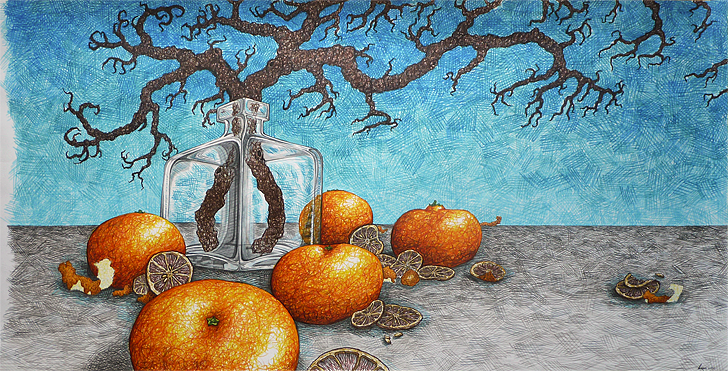To draw three-dimensional means to represent objects spatially. Their three-dimensional appearance is recognizable on the paper by means of special drawing techniques. Thus the drawing subject looks realistic and the shape is clearly recognizable. In this tutorial I will show you a few tricks to learn how to draw three-dimensional.
To begin with drawing 3D, it is best to exercise the sense of spatial representation and plasticity by observing and drawing objects with a simple geometry. Anyone who has gained some practice can try to find more complex and irregularly shaped objects.
The first and rather simple exercise is to draw a ball or other simple round object. The sphere is particularly suitable as an intuitive and practicing motif because its three-dimensional shape is optically defined only by shadows.
The ball contour, that is a circle, is first printed on paper. The unfilled circle does not yet appear plastically without a graphically illustrated light incidence and shadow. It could just as well be a slice. The sphere is rendered plastically by a small drawing effort.
How to draw a ball three-dimensional can be seen in the picture below using a colored example.
.jpg)
When drawing, a ball or a cylinder are particularly suitable for playing and experimenting with light and shadow. Nuances and variations result by light sources which are differently bright or differently positioned. Such exercises sharpen the eye for subtleties and playfully show many important aspects of the spatial drawing and painting.
.jpg)
In order to make the drawing appear not only plastically, but tangible and natural, three factors must be taken into account: the choice of the best perspective, the depiction of strong light-dark contrasts and the illustration of shadows and contours around the edges. The following are explanations and tips on these three points.
The first step towards a convincing three-dimensional representation is the decision for a suitable perspective. The light source is also important: Depending on its position, the light quantity, the angle of incidence of light, the darkness of the shadows and the shadow shape change, which sometimes makes the illuminated body seem more or less three-dimensional. The type of lighting also plays a role: plasticity is different in hard or soft light. This is due to contrasts, which should be discussed separately.

A further possibility of drawing objects through the choice of a favorable perspective is the change of the viewing angle. A hand can, for example, be drawn from above or below, but also from an oblique angle of view. When looking directly at the back of the hand or the palm of the hand, the three dimensions of the hand can not be shown perfectly. An oblique viewing angle or alternate posture of the hand - for example the spreading of one or more fingers - improve the spatial effect when drawing. The careful elaboration of details, such as contrasts, contours and shadows, make a drawing object even greater. If it is a still life with several objects, beautiful effects and interesting variations can be achieved by placing the objects and by experimenting with the lighting.
Contours and shadows render motifs in a three-dimensional drawing. By drawing strong contrasts between light and dark, this effect is intensified, because the shape of the object is defined by shadows. The weaker the contrasts are, the less spatial (the more "flat") the bodies appear. If you want to draw a sculpture, you should create very dark to black and also very bright - possibly completely white - areas.
.png)
A special drawing trick, in order to make subjects of a painting or drawing particularly three-dimensional, is the drawing of shadows to the contour / edges of the object. The light conditions do not always allow this little trick to be applied. However, if you draw from your imagination or use your artistic freedom anyway, you can usually get a whole lot out of the drawing. Important is that the edge shadows do not interfere with other shadows and original light conditions on the image and fall, for example, in illogical angles or wrong directions.
In the drawing below, you can see how the shadows on the edges of two cylinders improve the three-dimensional effect.
.jpg)
So much about drawing three-dimensional. I hope I was able to give you a few tips to improve your skills in letting your motives appear plastically.
This website is about how to draw and paint. You will learn to use pencil and brush and how to drawn and paint your own pictures.